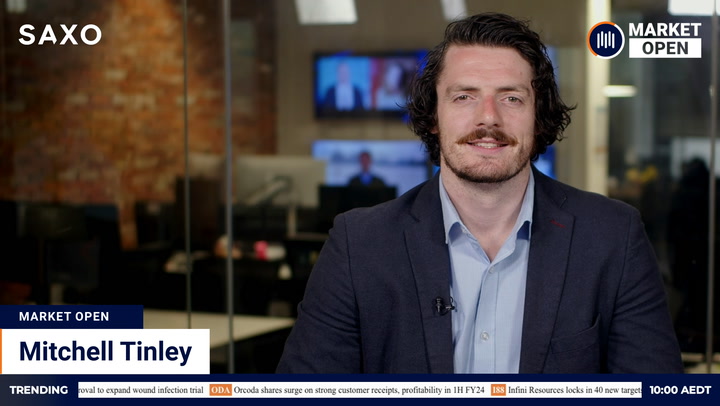The share market looks set for a fourth straight losing week after tech-led selling resumed on Wall Street after a single day’s respite.
ASX SPI200 index futures slumped 79 points or 1.3 percent, signalling further losses at the end of a choppy week. A fall of that magnitude would send the S&P/ASX 200 back towards Wednesday’s ten-week low and extend a run of weekly declines since mid-August.
Gold edged to a third straight gain. Oil, iron ore, industrial metals and the dollar declined.
Wall Street
Wednesday’s US rebound proved fleeting as stocks quickly gave up early gains overnight, finishing near session lows. The megacaps of the Nasdaq have dictated the market direction since the start of the pandemic and last night steered the Composite down 222 points or 1.99 per cent to its fourth loss in five sessions. The index had been ahead 1.4 per cent earlier in the night.
The S&P 500 shed 60 points or 1.76 per cent. The Dow Jones Industrial Average fell 406 points or 1.45 per cent after being up as much as 234 points.
“It’s a tricky market,” Arian Vojdani, investment strategist at MV Financial in the US, told CNBC. “You look up one second and the market’s down. You look down the other second and you’re back up. Investors would be remiss to try and trade on this right now.”
Momentum stocks that outperformed during lockdown were once again in retreat. Apple closed 3.3 per cent lower after being up as much as 2.7 per cent. The S&P 500 tech sector lost 2.3 per cent as Amazon shed 2.9 per cent, Microsoft 2.8 per cent and Facebook 2.1 per cent.
The Nasdaq entered a technical correction earlier this week following just three days of heavy selling, however, analysts warned that valuations remained elevated by historic standards.
“While a drop of this size from the peak sounds like a steep correction, it remains a minor one given the [Nasdaq] index had rallied 83 per cent from the March lows in a mere five months,” Hussein Sayed, chief market strategist at FXTM, wrote. “With a price to earnings ratio of 36, valuations for the index are still significantly overstretched, hence we should expect more volatility in the weeks to come heading into the US presidential election.”
Aussie outlook
The local market has been gently losing altitude since the middle of last month and looks set for a fourth straight weekly loss for the first time since the February-March pandemic plunge. Three anaemic rallies on Monday, Tuesday and yesterday appear likely to be outweighed by heavy falls on Wednesday and potentially today.
The energy and technology sectors were the biggest drags in the US, falling 3.7 per cent and 2.3 per cent, respectively. The Australian energy sector hit a four-month low on Wednesday as signs of weak demand weighed on crude. The domestic technology sector has more than doubled in value since March and has retraced less than 12 per cent from its August high, suggesting it is vulnerable to further losses if the market-leaders of the Nasdaq remain under pressure.
Gold rose for a third straight session, but US miners declined with the rest of the market: the NYSE Arca Gold Bugs Index shed 1.5 per cent.
US recovery prospects were mixed. The S&P 1500 airlines index was flat. Retailers, cruiselines and hotel/casino companies resisted the worst of the selling but did not make significant gains.
Commodities
The first weekly increase in US crude inventories in seven weeks sealed a losing night for oil. Brent crude settled 73 cents or 1.8 per cent lower at US$40.06 a barrel. The US benchmark eased 2 per cent to US$37.30. US crude inventories surpassed 500 million barrels – 14 per cent higher than the five-year average for this time of year, according to MarketWatch.
Materials was the best of the US sectors with a loss of 0.9 per cent, but that did not protect BHP and Rio Tinto. BHP’s US-listed stock dropped 2.93 per cent and its UK-listed stock 0.73 per cent. Rio Tinto gave up 1.68 per cent in the US after losing 0.13 per cent in the UK. The spot price for iron ore landed in China slid 90 cents or 0.7 per cent to US$126.30 a dry ton.
Gold edged higher for a third night as the European Central Bank’s decision to leave its rate policy unchanged weighed on the US dollar. Gold for December delivery settled $9.40 or 0.5 per cent ahead at US$1,964.30 an ounce.
A broadly negative night for industrial metals saw benchmark copper on the London Metal Exchange fall 1 per cent to US$6,690 a tonne. Nickel and lead fell 0.6 per cent, zinc 0.2 per cent and tin 0.1 per cent. Aluminium edged up 0.4 per cent.
The dollar declined 0.27 per cent to 72.56 US cents.







